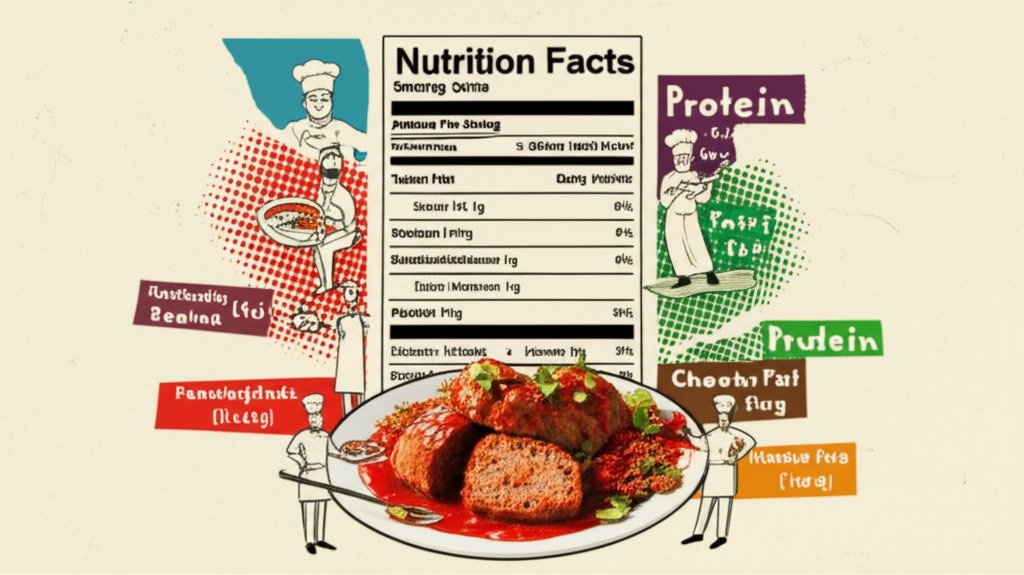Jell-O, that brightly colored, jiggly dessert, evokes childhood memories for many. But beyond the nostalgia, what are the jello nutrition facts? Is it a harmless treat, or are there things you should know before indulging? Let’s dive into the nutritional content of Jell-O, explore its potential benefits and drawbacks, and consider healthier alternatives.
At a glance:
- Regular Jell-O is low in calories but also low in essential nutrients.
- It’s primarily sugar and gelatin, offering little nutritional value.
- Sugar-free options are available, reducing sugar and calories.
- Gelatin, derived from collagen, might have some potential health benefits, but more research is needed.
- Consider homemade versions with fruit juice for a more nutritious treat.
What’s Actually In Jell-O?
The primary ingredients in Jell-O are gelatin, sugar (in regular versions), artificial sweeteners (in sugar-free versions), artificial flavors, and food coloring. Let’s break it down:
- Gelatin: This is a protein derived from animal collagen. It’s what gives Jell-O its signature jiggly texture.
- Sugar/Artificial Sweeteners: Regular Jell-O is sweetened with sugar, while sugar-free versions use artificial sweeteners like aspartame or sucralose. The nutritional profile varies significantly depending on which one is used.
- Artificial Flavors & Colors: These are added to create the different flavors and vibrant colors we associate with Jell-O.
Jello Nutrition Facts: A Detailed Look
Let’s get down to the specifics. Here’s a breakdown of the typical nutritional information for a 1/2-cup (about 4 ounces) serving of regular, brand-name Jell-O gelatin:
- Calories: 70-80
- Total Fat: 0g
- Cholesterol: 0mg
- Sodium: 30-65mg (varies by flavor)
- Total Carbohydrates: 16-19g
- Sugars: 16-19g
- Protein: About 1-2g
Now, let’s compare that to a similar serving of sugar-free Jell-O: - Calories: 10
- Total Fat: 0g
- Cholesterol: 0mg
- Sodium: 30-65mg (varies by flavor)
- Total Carbohydrates: 0g
- Sugars: 0g
- Protein: About 1-2g
The Good, The Bad, and The Jiggly: Weighing the Pros and Cons

So, what does this all mean? Here’s a balanced look at Jell-O’s potential benefits and drawbacks:
Potential Benefits:
- Low in Calories (Sugar-Free): Sugar-free options can be a satisfying, guilt-free treat for those watching their calorie intake.
- Fat-Free: Jell-O is naturally fat-free, making it a suitable option for low-fat diets.
- Easy to Swallow: Its soft texture can be beneficial for people with difficulty swallowing.
- Gelatin’s Potential Benefits: There is some evidence that gelatin may support joint health due to collagen production. However, more research is needed before conclusive claims can be made.
Potential Drawbacks: - High in Sugar (Regular): Regular Jell-O is packed with added sugar, contributing empty calories to your diet. It’s important to understand Lemonades Nutritional Information Here and similar treats if you want to make informed decisions.
- Low in Nutrients: Jell-O offers minimal vitamins, minerals, or fiber.
- Artificial Ingredients: The artificial flavors, colors, and sweeteners in some Jell-O varieties may be a concern for some people.
- Allergen Concerns: Gelatin allergies are rare but possible. Also, people with Alpha-Gal Syndrome (red meat allergy) may react to Jell-O due to the gelatin source.
- Not Suitable for All Diets: Jell-O made with animal gelatin isn’t suitable for vegans, vegetarians, or those following kosher or halal diets.
Jell-O Gelatin and Gelatin’s Potential Benefits: Separating Fact from Fiction
Gelatin, the key ingredient in Jell-O, is derived from collagen. Collagen is a protein found in animal connective tissues, bones, and skin. Some studies suggest that gelatin consumption may have potential health benefits, including:
- Joint Health: Gelatin may help support joint health by providing the building blocks for cartilage repair.
- Skin Health: Collagen is a key component of skin, and gelatin consumption may improve skin elasticity and hydration.
- Gut Health: Some research indicates that gelatin may help support a healthy gut lining.
Important Note: While these potential benefits are promising, more research is needed to confirm these effects. The amount of gelatin in a typical serving of Jell-O may not be enough to provide significant benefits.
Who Should Avoid Jell-O? Potential Risks and Considerations
While Jell-O is generally considered safe for most people, there are certain situations where it may be best to avoid it:
- Vegans and Vegetarians: Traditional Jell-O is made with animal gelatin, so it’s not suitable for those following plant-based diets.
- Kosher and Halal Diets: Some Jell-O products may not be kosher or halal due to the source of the gelatin (often pork).
- People with Allergies: Gelatin allergies are rare, but individuals with known allergies should avoid Jell-O. Those with Alpha-Gal Syndrome, an allergy to red meat often caused by tick bites, should also avoid Jell-O and other products that may contain mammalian-derived gelatin.
- People with Diabetes: Regular Jell-O is high in sugar, so people with diabetes should opt for sugar-free versions or consume it in moderation.
- Before Certain Medical Procedures: As mentioned earlier, certain colors of Jell-O (red, green, orange, purple) can interfere with colonoscopy results. Follow your doctor’s instructions regarding dietary restrictions before medical procedures.
Smart Ways to Enjoy Jell-O (If You Choose To)

If you enjoy Jell-O and want to incorporate it into your diet, here are some tips for making healthier choices:
- Choose Sugar-Free: Opt for sugar-free varieties to reduce your sugar intake.
- Control Portion Sizes: Stick to a single serving to limit calories and sugar.
- Enhance with Fruit: Add fresh or frozen fruit to your Jell-O for added vitamins, minerals, and fiber.
- Make Your Own: Consider making your own Jell-O using unsweetened gelatin powder and fruit juice or puree. This allows you to control the ingredients and reduce added sugar.
- Be Mindful of Artificial Ingredients: If you’re concerned about artificial flavors, colors, or sweeteners, look for natural alternatives or make your own Jell-O from scratch.
Jell-O Alternatives: Healthier Ways to Satisfy Your Sweet Tooth
If you’re looking for healthier alternatives to Jell-O, consider these options:
- Chia Seed Pudding: Chia seeds are packed with fiber, protein, and omega-3 fatty acids. Mix them with milk (dairy or non-dairy) and your favorite toppings for a nutritious and satisfying pudding.
- Fruit Salad: A colorful mix of fresh fruits is a naturally sweet and healthy dessert option.
- Yogurt Parfait: Layer yogurt (Greek yogurt is a good source of protein) with granola and fruit for a balanced and delicious treat.
- Homemade Fruit Popsicles: Blend fruit and juice and freeze in popsicle molds for a refreshing and healthy dessert. You can even add a bit of protein powder!
- Agar-Agar Desserts: Agar-agar is a plant-based gelatin alternative that can be used to create vegan-friendly jiggly desserts.
Common Questions About Jello Nutrition Facts
Let’s clear up some common questions about Jell-O:
- Is Jell-O a good source of protein? No, Jell-O is not a significant source of protein. While it contains some gelatin, the amount is relatively small.
- Can Jell-O help with weight loss? Sugar-free Jell-O can be a low-calorie option for those trying to manage their weight. However, it’s important to focus on a balanced diet and regular exercise for sustainable weight loss.
- Is Jell-O good for you when you’re sick? The soft texture of Jell-O can make it easy to swallow when you’re sick. However, it’s not a significant source of nutrients. Clear broths, fruits, and vegetables are generally better choices for providing nutrients and hydration.
- Does Jell-O expire? Yes, Jell-O has a “Use By” date. It should be stored properly (refrigerated for prepared Jell-O) and consumed before the expiration date.
- Can Jell-O be frozen? Freezing Jell-O is generally not recommended as it can alter the texture and make it watery.
The Final Verdict: Jell-O in Moderation
Jell-O is a classic dessert that can be enjoyed in moderation as part of a balanced diet. Opt for sugar-free versions to reduce your sugar intake, enhance it with fruit for added nutrients, and consider making your own from scratch to control the ingredients. Be mindful of potential allergens and dietary restrictions. It’s also important to consider the full nutritional profile of your meal; for example, what are the Meatball Nutrition: Get the Facts and how can they affect your overall calorie intake?
Ultimately, the decision of whether or not to eat Jell-O is a personal one. By understanding the jello nutrition facts and making informed choices, you can enjoy this jiggly treat responsibly.
- Why Glass Boxes for Lunch Are Trending for Meal Prep - December 17, 2025
- Bento Box Glass Offers Practical, Eco-Friendly Meal Storage - December 16, 2025
- The Best Bento Box Price For Your Perfect Packed Lunch - December 15, 2025










